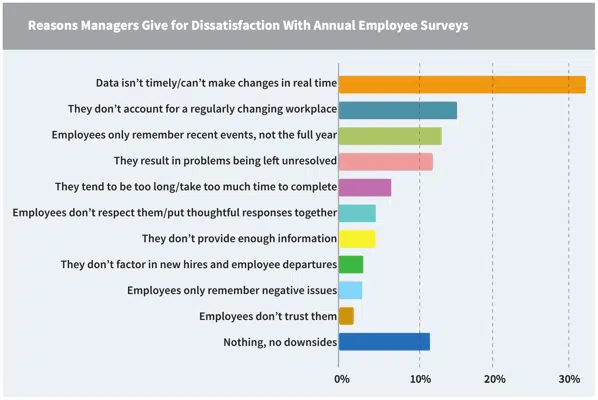FedEx Corporation tracks its employee satisfaction and outlook using an annual survey. According to FedEx efficiency of company and employee is directly related to satisfaction.
Thus after conducting the survey the management analyses the results to achieve the objectives of the organization and at the same time meets the expectations of employees.
The policies are framed accordingly to bring out the best of their employees.
On the other hand Marks and Spencer runs three pulse survey in each quarter. It has enabled managers to hit engagement as Key performance indicators.
Philips wanted to ensure continuous communication between managers and their teams to enable immediate action.
To achieve this they introduced a pulse survey that helped ongoing developments.
Human resource is considered the most important asset of the organization. So, it is imperative to keep the employees contented and engaged.
Else, things can turn south fast for the employer.
This can be achieved by assessing their feedback received via surveys using an employee engagement software.
The survey can be of a different type depending on the industry type.
However, the most commonly used surveys are Annual Surveys and Pulse Surveys.
Below is the deep insight about both the surveys and which is best catering to your requirements.
Annual Surveys vs Pulsing Surveys -Which one is right for me?
An Employee Engagement survey is a comprehensive and productive exercise to get a fair idea about the employees’ frame of mind.
Employee Engagement survey helps the Organization in assessing employees overall satisfaction with the work and organisation.
It helps in engaging the employees in organizational activities better.
Also read: Signs Your Employee is Unhappy with His Job
ANNUAL SURVEY
As the name suggests Annual Survey is a yearly survey and is the most widely used by organisations in any industry.
The HR department of almost all the organization considers this survey as the most important tool.
It is a reliable method to get an in-depth insight into employees’ behaviour and attitude towards the organization.
It consists of minimum 50 questions pertaining to how an employee feels about various aspects at work.
The responses are collected through binary questions or on a scale.
Pros of Annual Survey
- It is the most sought after the survey by the HR Department as it is a detailed survey. It helps in gathering a lot of data related to employees’ outlook to various changes in the organisation that takes place during a year.
- It allows the HR Department to understand the causes of employee turnover or retention.
- The survey helps determine the employees’ emotional commitment towards an organisation and job satisfaction levels. It also assesses employees ’ reaction to various company policies.
- It is a good method of employee engagement as it gives the employee a sense of belonging. They get a sense of ownership which is vital for any organization’s growth. This builds trust and strengthens the employer’s relationship with his employees.
- The survey brings in a positive work environment. Such an environment help boost the performance of employees and helps in achieving overall organisational goals.
- Owing to the above-mentioned benefits, HR Department of top companies conducts this survey in their organization. This maintains the overall satisfaction of employees.
Cons of Annual Survey
Unreal Insights
Since they are done once a year they fail to provide real insights.
HR department takes the risk of asking their most valuable asset i.e. the employees just once a year about how they feel.
Unreliable data
With so many changes happening throughout the year, a survey conducted once would provide inadequate and unreliable data.
For Example, a happy employee in August might not feel the same by the year end.
This would result in unreliable data.
To tap and cater to all these changes regularity must be ensured.
Leaves employee fatigued
Another drawback is that since it is a detailed survey it involves a good number of questions which become time-consuming.
Fatigued by the survey, the employee may end up answering fast without being attentive.
Lengthy and Complex
Sometimes the lengthy nature of this survey also leads to absenteeism.
Being a detailed survey, it is complex to design and analyse the data gathered.
Impersonal
This Yearly survey is impersonal and lacks transparency.
The data collected using this survey leads to ambiguity.
Some employees tend to answer the survey based on the recent event.
Some, on the other hand, may respond to policies that were framed at the beginning of the year.
So the responses get mixed up thereby hampering analysis and conclusion.
In a research, few managers of different organizations were asked about the problems they faced with annual surveys.
They provided with a list of common problems. below is the list –

According to the common feedback received from all the managers, the biggest problem of the annual survey was that it is hard to get and act on good feedback if it happens annually.
Most of the managers said the survey should be done fortnight for effective decision making.
PULSE SURVEY
Pulse Survey is a short and specific survey focussing on the specific aspect of work or organization.
They Do not require much time to respond as they consist of 1-10 questions only.
They help in getting real-time insights as they are to the point and are regular in nature.
They allow the HR to get immediate feedback to any change in policy or any change in the organization.
This survey can be conducted weekly or monthly.
The regularity of this survey helps in effective workforce management. Pulse Survey could be on anything from a change in organizational policy to the chairs they sit on.
It paves way for effective communication and immediate action.
Pros of Pulse Survey
- Pulse survey is quick and specific survey allowing the HR to get a clear understanding of employees behaviour or feedback.
- The crispness of this survey makes it easy to design and analyse.
- Few questions make it easy for employees to answer and this encourages them to take the survey happily. The data gathered is specific to a situation which makes it easy to analyse and expedite reforms.
- Frequent pulsing helps retain workforce as they feel they are involved. This helps the organisation reduce recruitment cost and build employee brand proposition.
- More employee engagement leads to greater innovation and improvement. This enables better development in the future.
- Pulse survey gives instant business-centric feedback and real insights. As a result, it is gradually becoming the latest craze amongst the HR Department. Many organisations are introducing this survey as a part of HR Practice.
Cons of Pulse Survey
- Running pulse surveys frequently can lead to disappointment amongst employees. When a survey is conducted employee expect that the feedback will lead to change.
- However, management might not anticipate long-term benefits from that change. This can create conflict between manager and teams. Moreover, conducting these surveys regularly result in increased cost to the company.
- At times frequent surveys give birth to unnecessary grapevine in the organization which indirectly affects the performance of the workforce. For example, if a company indulges in a survey about Managers leadership ability. It might lead to speculation about that Manager’s repo with the Founders and Directors.
To conclude let us look at a survey done by a Cvent’s research.
According to them, pulse surveys are more effective for both the employee and the employer.
The reason behind it is a short survey has fewer questions which help the employee to be more concentrated and thoughtful.
Which one is good for you?
Choosing the right survey is significant in reaping the intended benefits.
Annual Surveys and Pulsing Surveys are equally beneficial but the choice depends on below-mentioned factors.
Size of the Organization
If the organization is large then Pulsing proves to be effective.
Pulse survey is specific and in a large organisation, teams are more in number.
Hence each team needs a specific survey. However, if the organisation is small in size an Annual survey can suffice.
Objectives of the Organization
The choice is based on the organizational objectives too.
For example, In case a company is planning a big merger than Pulse Survey will prove to be the best suited.
As it can give immediate feedback of the workforce.
In these situations, we cannot choose the annual survey.
Waiting for a year to get feedback on a merger due next month would be worthless.
The flexibility of the Organization
Type of survey highly depends on the Organization’s flexibility to incorporate changes.
Regular pulsing improves flexibility to help dive deeper into the employee’s’ mind.
But at the same time, it should be kept in mind that Pulse Survey is frequent.
Thus they should be conducted only when the organization is in a position of incorporating the feedback.
If the organisation fails to bring in a change despite feedback, it leads to dissatisfaction amongst employees.
Purpose of Survey
The purpose with which survey is initiated determined the type of survey.
If the HR Department wants an overall analysis then Annual Survey becomes suitable.
If they want a glimpse of an employees’ attitude then Pulse Survey helps.
Requirements of Organization
If the survey requires a small sample of employees then Pulse Survey should be opted for by the HR Department.
If the feedback of the entire workforce is required then Annual Survey is viable.
Conclusion:
An annual survey is more like a traditional survey among HR departments whereas pulsing is a new trend.
A judicious mix of both can help nurture professionalism at its best helping organization to prosper at a rapid rate.
The annual survey cannot be replaced by a pulse survey but pulsing can definitely complement the annual survey.
Therefore a comprehensive annual survey for a complete picture mixed with two or three pulse survey would be ideal for any organisation’s growth and measure its employees’ behaviour.








